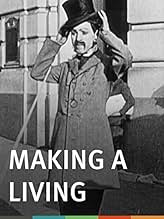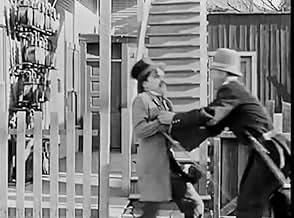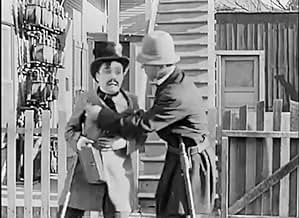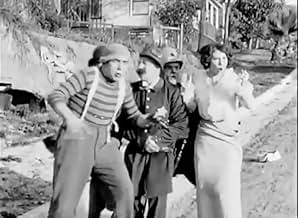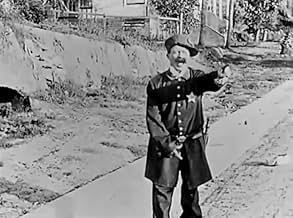Ajouter une intrigue dans votre langueAn out-of-work swindler takes a job as a reporter. After witnessing a car go over cliff, he grabs a rival reporter's camera and races to the newspaper office to enter the photo as his own. H... Tout lireAn out-of-work swindler takes a job as a reporter. After witnessing a car go over cliff, he grabs a rival reporter's camera and races to the newspaper office to enter the photo as his own. His rival is delayed when he gets caught in a woman's bedroom by her jealous husband. The s... Tout lireAn out-of-work swindler takes a job as a reporter. After witnessing a car go over cliff, he grabs a rival reporter's camera and races to the newspaper office to enter the photo as his own. His rival is delayed when he gets caught in a woman's bedroom by her jealous husband. The swindler follows the distribution of the paper containing his 'scoop' around town where he ... Tout lire
- Réalisation
- Scénario
- Casting principal
- Tough guy
- (non crédité)
- Jealous Husband's Wife
- (non crédité)
- Policeman
- (non crédité)
- …
- Mother
- (non crédité)
- Girl
- (non crédité)
- Jealous Husband
- (non crédité)
- Seated Man with Editor
- (non crédité)
- Newspaper Editor
- (non crédité)
- Wreck Bystander
- (non crédité)
- Daughter
- (non crédité)
- Cops
- (non crédité)
- Reporter
- (non crédité)
- Bald Man in Newspaper Office
- (non crédité)
- Cop at Apartment Steps
- (non crédité)
- Onlooker
- (non crédité)
Avis à la une
The first thing we notice is that the familiar costume hasn't been developed yet. In the very first shot, when Chaplin approaches his co-star (and director) Henry Lehrman to ask for a hand-out, it takes us a moment to adjust to his exotic appearance: he wears a top hat, tan frock coat, and droopy mustache. He looks a bit seedy but he's not exactly a tramp, more like an eccentric gent who is down on his luck. It's interesting to observe Chaplin in this extended opening sequence as he puts the touch on a man who is, apparently, a total stranger. He engages Lehrman in light conversation, examines the man's ring, briefly pretends to steal it, chuckles winningly, and then gets down to the business of genteel pan-handling. At first Lehrman refuses him a loan, but when he relents and offers cash Chaplin suddenly turns him down -- and then, as the offer is withdrawn, quickly grabs it. It's a nice little scene, more relaxed and nuanced than what we might expect.
All that follows is more conventional, as it details the escalating (and increasingly violent) rivalry between Chaplin and Lehrman, first over the same girl and then over the same job, at a newspaper office. Along the way we recognize some Chaplin expressions and mannerisms familiar from later performances, but we also note that Charlie's character is decidedly unsympathetic: he's a con man who repeatedly double-crosses his reluctant benefactor, Lehrman. At one point during a battle Chaplin holds Lehrman at bay with his walking stick, as he later would with Eric Campbell in The Rink (1916), but The Little Tramp seems worlds away. Eventually, when Lehrman manages to take some photos at the scene of a car accident, Charlie steals his camera and attempts to pass off the photos as his own. What a scoundrel!
For a newcomer to movie-making Chaplin appears perfectly relaxed before the camera. Despite all the scuffling and running around that takes place here, both Chaplin and Lehrman (who doesn't display much screen presence) give performances that are noticeably more restrained than the Keystone norm of the time. Towards the end, when Chester Conklin appears as a cop, his grotesque makeup and out-sized reactions look quite exaggerated in contrast to the two leads. It's also interesting to observe that Chaplin and Lehrman, who quickly developed an intense mutual antipathy off-camera, spend most of their on-screen time together as adversaries, both in this film and in Kids' Auto Race, made soon afterward. It seems that Chaplin was signaling, from the very outset, that he would not passively submit to direction from others -- or at least not from Henry Lehrman. And it wouldn't be long after this, just a few months, before Chaplin would be directing his own work, and his brilliant career would be launched in earnest.
This is a Keystone short, so there is quite a bit of slapstick humor. Perhaps it's due to this movie being over 90 years old when I saw this, but I could not tell what exactly happened between Chaplin and the reporter (played by director Henry Lehrman). There are a few interesting parts.
If you are a fan of Chaplin and can't get enough of his work or a fan of silent slapstick comedies, this might be worth a look. Then again, it's only about 8 or 9 minutes long, so if you don't like it, you haven't wasted much of your time.
It looks very much as if the film has deteriorated quite a bit physically, which makes it somewhat difficult to tell how good it may have been originally. Not that it would have been anything exceptional anyway, but some of the frantic action would probably be easier to follow if the print were in better shape, without anything missing.
Here, Charlie plays a character who is continually looking for ways to outwit a rival as he tries to make good. He gives the role plenty of energy, as you would expect, and he does as much as anyone could have within the limitations of the story line. In itself, it's nothing special, but to anyone who enjoys silent films, it's well worth watching just to see what the start of Chaplin's career was like.
Many of Charlie's mannerisms are already very recognizable, and it is interesting to consider how similar his stage acting was to his film acting, since his style is already so clear. Consider his behavior upon noticing the Help Wanted sign, as well as the extensive fight scenes, which are even more breathless here than usual, since the pace of the film is so much faster than many of his short comedies of the time, given the primitive filming equipment.
Making A Living is a very unique film in Chaplin's filmography, not only because it is his first screen appearance, but also because it represents a real testing period in which he was truly unsure of himself as a screen actor. One cannot deny that it is interesting to consider how Chaplin looked back on this film in forming his persona, and what he thought worked here and what he should change. Also of note is the film's final shot, which features a stunt gag, something that would be very common in his later short comedies of this period.
Some have said that this is a film only for Chaplin fans and that casual fans of silent film should skip it, but I disagree. Chaplin is considered by many to be the greatest screen comedian of all time, but if you keep in mind that this is his first screen appearance and therefore not one of the greatest silent comedies of all time, I should think that any viewer with even a mild interest in silent film should find it interesting and entertaining.
Le saviez-vous
- AnecdotesFilm debut of Charles Chaplin. NOTE: One of the few films in those early years in which he does not play the Tramp.
- ConnexionsFeatured in Hollywood and the Stars: The Funny Men: Part 1 (1963)
Meilleurs choix
Détails
- Date de sortie
- Pays d’origine
- Sites officiels
- Langues
- Aussi connu sous le nom de
- Making a Living
- Société de production
- Voir plus de crédits d'entreprise sur IMDbPro
- Durée11 minutes
- Couleur
- Mixage
- Rapport de forme
- 1.33 : 1
Contribuer à cette page


